Physical Address
304 North Cardinal St.
Dorchester Center, MA 02124
Early glottic cancer commonly presents as dysphonia associated with a white or red lesion of the vocal cord.
Laryngeal leukoplakia is defined as a white lesion of mucosa that, based on its clinical features, cannot be assigned a definitive diagnosis.
Biopsy is the standard management of leukoplakia and serves to assess for either malignancy or risk for subsequent development of malignancy based on degree of dysplasia.
Patients (from an aggregate report of multiple publications) with laryngeal leukoplakia who are followed for 3 years following biopsy will develop invasive cancer in approximately 4% without dysplasia, 10% with mild/moderate dysplasia, and 18% with severe dysplasia/carcinoma in situ (CIS).
The glottis represents the site where approximately 50% of laryngeal cancers arise; 95% of laryngeal malignancies are squamous cell carcinoma.
Glottic cancers are considered “early” when they are defined as either stages 0 (TisN0M0), stage I (T1N0M0), or stage II (T2N0M0).
Tis represents carcinoma in situ (stage 0) which is considered synonymous (by many pathologists) with severe dysplasia, also termed squamous intraepithelial neoplasia Grade 3.
Invasive early glottic cancer (stage I and II) is classified according to cord mobility (T1 normal, T2 impaired) and spread outside the glottis (T1a one cord, T1b both cords, T2 supraglottis or subglottis).
Five-year relative survival is approximately 90% for T1N0 tumors and 75% for T2N0 glottic squamous cell carcinoma.
Second primary tumors (lung followed by head and neck) are the most common cause of death in patients with early glottic cancer.
Diagnosis of glottic cancer is by laryngoscopy and biopsy. Evaluation may include a CT (or MRI) of the larynx for cartilage invasion and paraglottic space assessment. Advanced imaging is generally not needed for small mid-membranous vocal cord cancers.
Radiotherapy is an effective treatment modality and is the most commonly used modality for early glottic cancer in North America.
Treatment with radiotherapy may result in the best final voice quality in some patients retaining their larynx. Close follow-up is valuable for early detection of persistent/recurrent disease to offer the best chance for cure and to increase the opportunity for salvage with laryngeal conservation surgery.
Radiation therapy may be the best choice for those with medical comorbidities that increase surgical/anesthetic risks.
Radiotherapy for early glottic cancer can have rare late sequelae, such as hypothyroidism, radiation-induced cancers, and carotid artery stenosis.
Larynx-preserving alternatives to radiotherapy include open laryngeal conservation surgery as well as transoral endoscopic approaches, either for resection or for less commonly used ablative treatments, including photodynamic and photoangiolytic laser treatment.
Treatment choice should engage the patient as an educated participant with an understanding that the ramification of their decision extends beyond the simplified (but widely accepted) concepts that surgery is generally considered to have a higher rate of final laryngeal preservation and radiation may offer better voice preservation.
Initial evaluation with yearly interval screening should include consideration for low-dose CT (LDCT) imaging of the chest to supplant the routine chest x-ray that had been recommended for screening in the past.
The appropriate definition of the term early as it applies to laryngeal cancer has been debated. Some investigators have loosely used early to describe laryngeal cancer in the context of management options. By this convention, a laryngeal cancer is considered early if it can be treated by partial laryngeal (conservative) surgery, by endoscopic excision, or by radiotherapy alone. Others apply the term early to stage 0, I, or II tumors and late to stage III or IV tumors. Because the extent of disease—not the rate of growth—determines staging, the term localized may be more accurate than the term early. Similarly, the term advanced may be more appropriate than the term late. The most accurate grouping uses the terms localized for any-TN0M0 disease, regionally spread or vicinally spread for any-T-N-positiveM0 disease, and widely disseminated for any-T-any-NM1 disease. Convention and tradition dictate that this chapter continue to use the terms early to refer to lower stage (0, I, and II) and late to refer to higher stage (III and IV).
Discrimination between a precursor lesion and an early invasive cancer may be difficult and almost always requires a biopsy to fully characterize. The appearance of diffuse carcinoma in situ (CIS) of the glottic larynx progressing to mild/moderate dysplasia to recurrent CIS to invasive cancer (following initial treatment with irradiation) is identified in a nonsmoker with the onset of dysphonia 1 year before initial diagnosis in November 2010 ( Fig. 106.1A to C ).
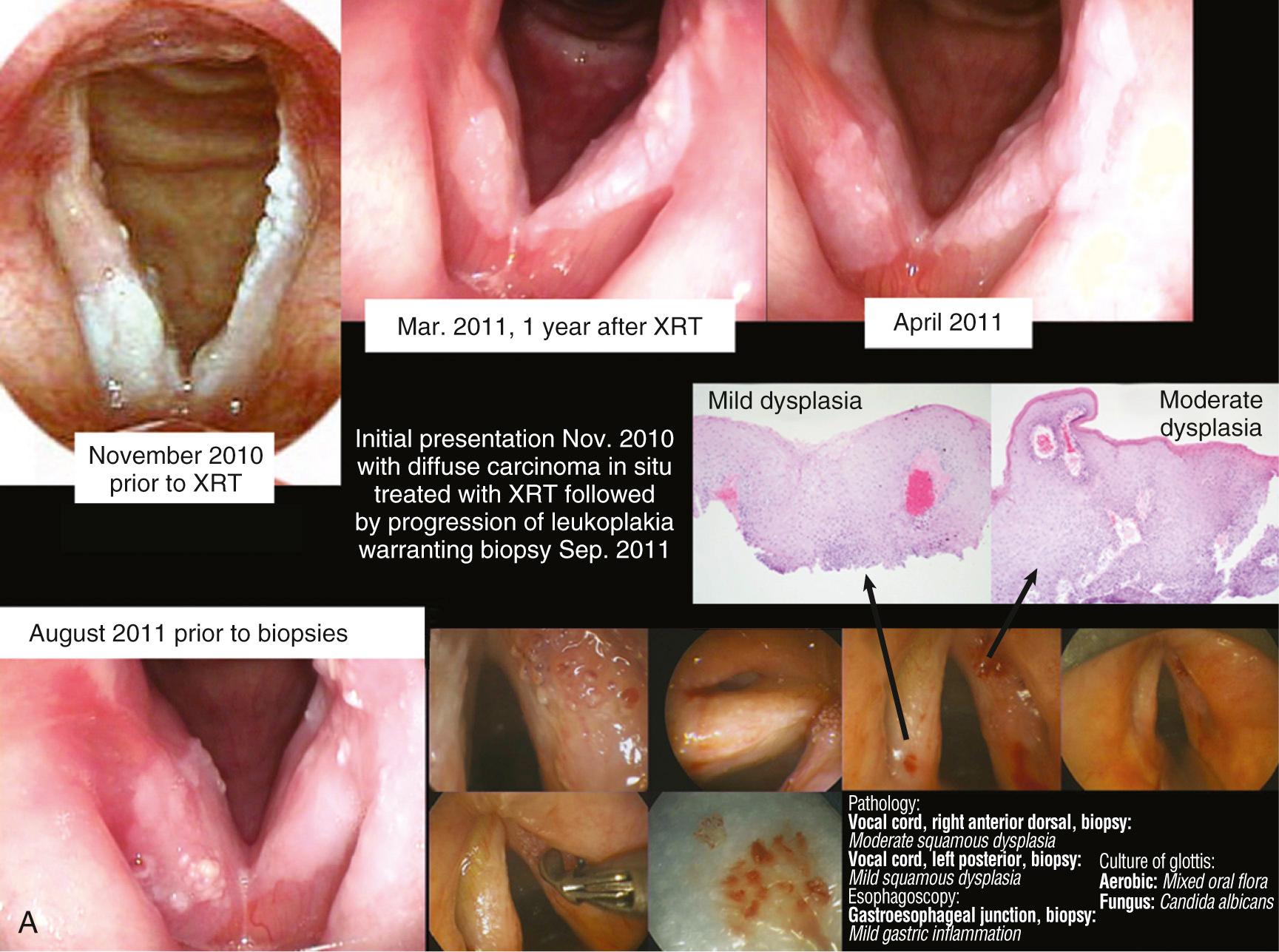
The initial evaluation of a patient with an early glottic lesion requires inspection of the larynx. The common use of flexible transnasal laryngoscopy to supplement indirect mirror examination permits visualization of the majority of laryngeal cancers in a clinical setting. Although flexible fiberoptic laryngoscopy (FFL) is a term commonly used for this procedure, the term “fiberoptic” does not accurately reflect the increasingly common use of imaging through use of a distal chip camera rather than fiberoptic cables. Fiberoptic endoscopes are still commonly used, but do not generally provide the image clarity available through distal chip technology.
Videoendoscopy and videostroboscopy offer further refinement in assessing glottic lesions. It is standard practice in many institutions to permanently record the appearance of all laryngeal cancers through video recording, using rigid or flexible endoscopy. The capacity to refer to these permanent records documenting the extent of the original lesion often improves long-term patient care.
The development of flexible endoscopes designed for operative transnasal endoscopy has also permitted use of these instruments to evaluate the larynx and trachea. The improved optics of these instruments—coupled with the presence of a side port that permits the use of suction, placement of biopsy instruments, and instillation of topical anesthetics—has expanded the capacity to perform in-office laryngeal evaluations ( Fig. 106.2A ). Although direct laryngoscopy remains an appropriate approach to evaluate and biopsy the majority of lesions suspected of being malignant, in appropriately selected cases biopsy can be appropriately effected in the clinic (see Fig. 106.2B and C ).

When videostroboscopy was initially introduced as a common clinical tool, enthusiasm was high for its potential to help discriminate invasive cancer from epithelial atypia on the basis of the stroboscopic appearance of the vocal fold epithelial pliability. Subsequent experience of Colden and colleagues has identified that laryngeal stroboscopy is neither reliable in distinguishing vocal fold atypia from invasive cancer nor useful in determining the depth of invasion of vocal fold cancer. These investigators did suggest that the stroboscopic appearance of a relatively normal mucosal wave indicates that a lesion is superficial and does not extensively involve the underlying vocal ligament.
Advances in technology, coupling physical and biologic analysis to endoscopy, have identified several adjuncts to complement standard imaging of the larynx at the time of direct laryngoscopy. Lugol solution, as well as toluidine blue, has been used to stain laryngeal tissue in an effort to discriminate normal tissue from tumor. These approaches have not met with uniform success and therefore have not been widely adopted. Fluorescent tumor markers such as tetracyclines and hematoporphyrin derivatives are preferentially absorbed by tumor cells and can be used to discriminate tumor from adjacent normal tissue by the red fluorescence they emit when exposed to ultraviolet light. Additional cost and operating time, as well as problems with skin photosensitivity, have limited the usefulness of this technique. A more promising approach employing autofluorescence laryngoscopy has been reported. Zargi and colleagues have employed the lung imaging fluorescence endoscope (LIFE) system to evaluate laryngeal lesions. Their preliminary work identified differences in the intensity of autofluorescence between normal and tumor tissue when exposed to blue or violet light. They also identified shortcomings in the use of the LIFE system for this purpose, noting that further technical advances are necessary to make this endeavor a useful clinical tool.
Stone and colleagues reported that the fluorescence of biologic tissue actually may impede the use of Raman spectroscopic analysis to discriminate normal from malignant laryngeal lesions. These investigators have developed strategies that negate the impact of the natural biologic fluorescence to permit evaluation of the distinctive spectral signatures of tissues elicited when exposed to monochromatic laser excitation. A recent publication (2013) compared the “gold standard” of operative microlaryngoscopy with histopathologic examination versus office-based endoscopy with the combination of autofluorescence fiberoptic endoscopy (AFE) and standard white-light rigid laryngostroboscopy . These investigators found no added diagnostic value to the use of autofluorescence and sufficient error in the clinical diagnosis based on standard videostroboscopy that they conclude “microlaryngoscopy with histopathologic examination and phonomicrosurgical excision of pathologic changes remains the gold standard.”
The use of light with wavelengths narrowed by filtering may offer additional perspective in the assessment of glottic lesions in the clinic and in the operating room. Narrow-band imaging (NBI) may highlight microvascular abnormalities to help distinguish normal from abnormal and also help direct biopsies ( Fig. 106.3 ).
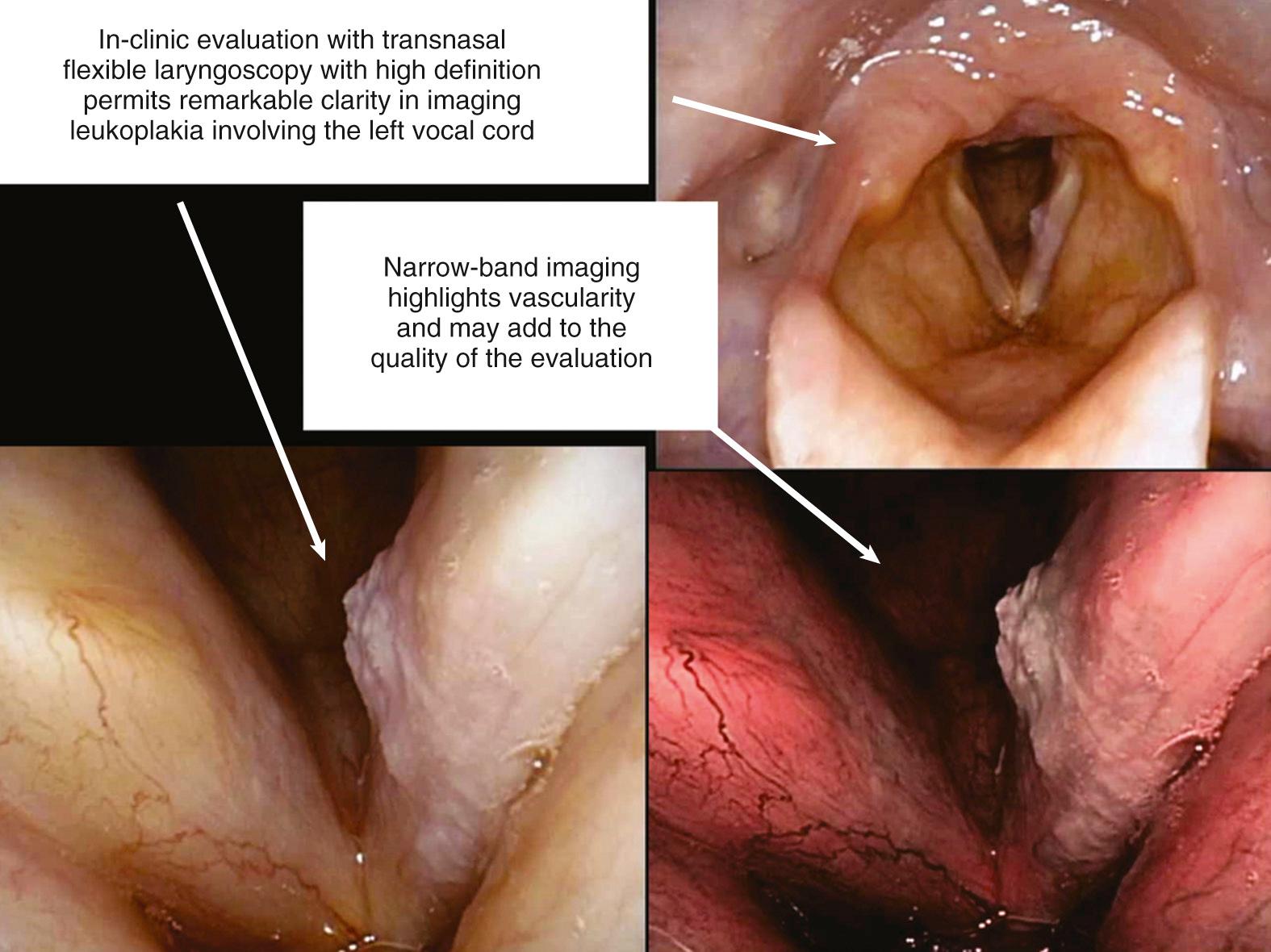
Multiple strategies are under assessment to develop a noninvasive tool for the early detection of cancerous and precancerous lesions. For example, optical coherence tomography (OCT) is a technique that uses infrared light to provide cross-sectional imaging of the laryngeal epithelium with acute resolution. This technique has received recent support as a tool in the diagnosis of smaller epithelial lesions, guiding resections, and to monitor the larynx after therapy.
In addition to the use of light as a medium to assess the type and extent of glottic neoplasia, endoscopic ultrasound at the time of direct laryngoscopy has received renewed attention to assess degree of tumor infiltration implementing recently developed equipment. To date, these approaches have failed to supplant laryngoscopy with biopsy as the standard approach.
Imaging of the chest through computed tomography (CT) or chest x-ray has been reported to be useful in the evaluation of patients with glottic cancers to assess for concurrent pulmonary disease and to screen for second primary lung cancers. The incidence of distant metastatic spread of an early glottic cancer to the lung is sufficiently rare that pretreatment chest imaging is not generally intended to survey for that specific purpose. Annual chest x-rays have been supported as useful in the past in the course of clinic follow-up examinations primarily because of the high incidence of second primary lung cancers in patients managed for laryngeal cancer.
Advances in screening for lung cancers with low-dose CT (LDCT) imaging has led to new recommendations from the U.S. Preventive Services Task Force (UPSTF). A systematic review by the UPSTF identified a significant reduction in mortality from lung cancer (20%) and from all-cause mortality (6.7%), and prompted the introduction of LDCT screening for asymptomatic populations at risk for lung cancer. Improved application of LDCT for screening includes a decrease in the radiation dose as well as improved detection through computer-aided diagnosis (CAD) as a second reader. National organizations have published recommendations for screening to include 50-year-old smokers with 20 pack-years and another risk factor such as family history or radon exposure. Other published guidelines identify that 55- to 74-year-olds who are current or former smokers with a 30 pack-years smoking history are appropriate candidates for LDCT screening. Other guidelines recommend screening to include lung cancer survivors because of their high risk of a second lung primary. The development of strategies for nodule assessment has also improved the utility of this approach. One published strategy is to include repeated interval imaging with CT for low cancer risk nodules (<10%), to include further assessment with positron emission tomography (PET)/CT for those nodules with a moderate risk (10% to 60%), and surgery for those with high risk (>60%).
A European work group in 2012 published guidelines indicating that a screening chest CT was useful in initial assessment of early stage laryngeal cancer. These investigators concluded that neither a chest x-ray nor fiberoptic bronchoscopy were useful in supporting this initial assessment. They additionally identified value in screening the esophagus with flexible endoscopy for the routine pretreatment evaluation of patients with laryngeal cancer who had a history of chronic alcohol intoxication, and more liberal application for those with hypopharyngeal and oropharyngeal primary cancers. They identified significant shortcomings to use of rigid esophagoscopy when compared to the preferred flexible fiberoptic exam and offered the comment that use of NBI “seems promising, but remains to be validated” ( Fig. 106.4 ).
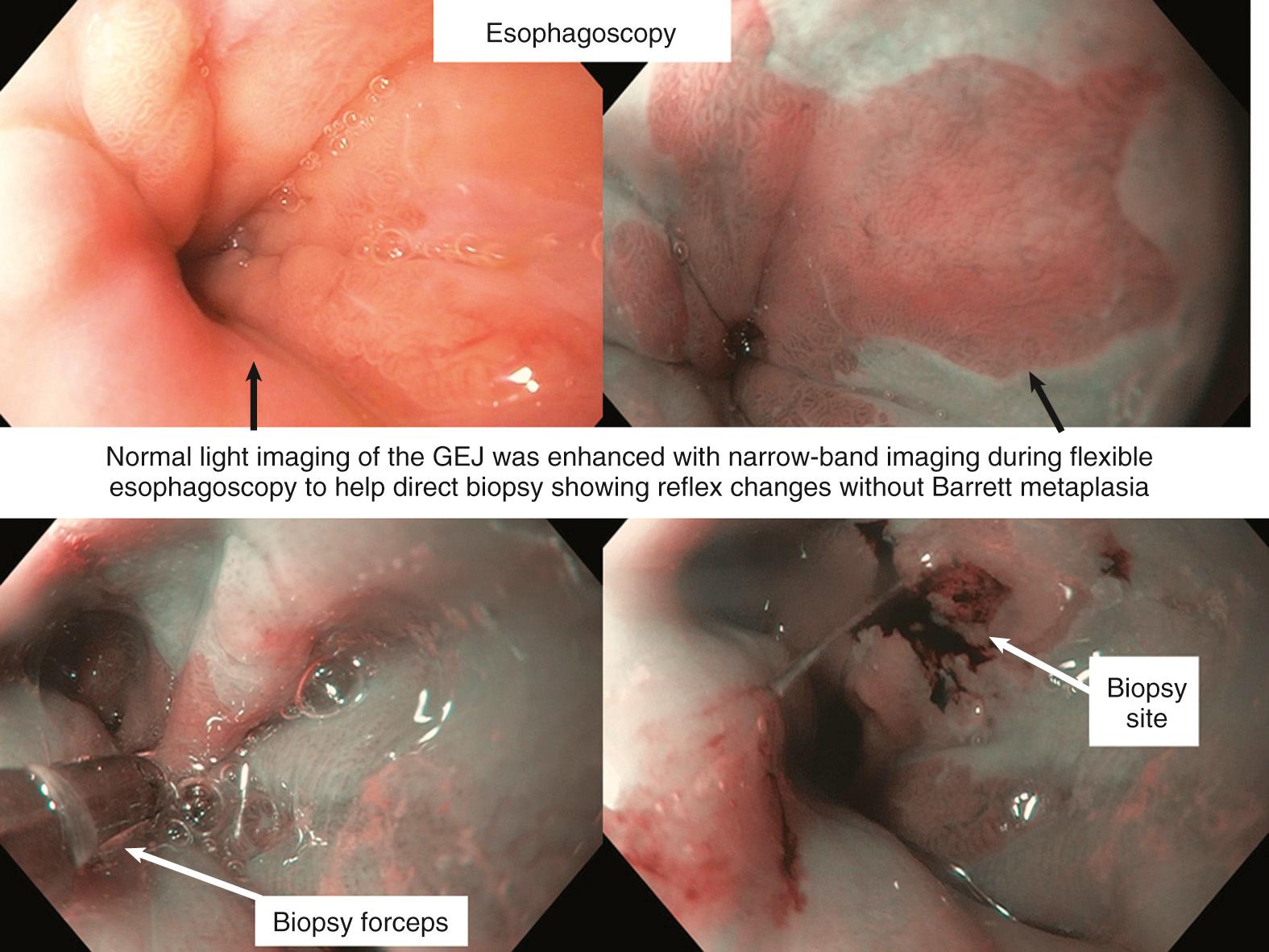
Chest CT is more sensitive; practitioners should be cautioned that use of chest CT for screening in early glottic cancer may lead to identification of clinically insignificant nodules. In the initial assessment of a patient with early glottic cancer, use of CT to evaluate for lung nodules is a complex decision which merits discussion between patient and physician.
In our institution most early laryngeal cancers will be assessed through clinical exam, endoscopy, and most commonly with a fine-cut CT to assess for spread into the paraglottic space and potential invasion into or through the thyroid cartilage. The appropriate role for magnetic resonance imaging (MRI) and CT in early glottic cancers is still being defined. These advanced imaging studies are of questionable value in the assessment of most superficial T1 lesions of the vocal cords. Selected T1 lesions with anterior commissure involvement may benefit from MRI or CT imaging if extension of the tumor superiorly into the preepiglottic space or anteriorly into the thyroid cartilage is detected. The more routine use of MRI or CT is advocated in the evaluation of T2 lesions not only to help determine tumor extent (and hence T classification) but also tumor volume. Some authors have suggested that CT or MRI of T2 lesions may help determine radiocurability by assessing tumor volume. Other investigators have not found the size of the tumor to be useful for predicting radiocurability.
Wenig and colleagues contend that surgical treatment of laryngeal cancer with less than a total laryngectomy mandates preoperative MRI in almost all cases. These investigators identify that tumor involvement of the entire vocal cord or the anterior commissure, as well as the presence of vocal fold paresis, is considered an indication for the use of MRI. They relate that only the most superficial T1 lesions of the mobile portion of the vocal cord need not be imaged because MRI will not detect the extent of these lesions. This philosophy is distinctly opposite from that of Steiner and Ambrosch, who relate that advanced imaging of laryngeal cancer is fraught with artifact. Steiner and Ambrosch find little value in preoperative imaging of laryngeal cancers and relate that the most accurate assessment of tumor extent comes at the time of endoscopic laser microsurgical resection.
Debate continues as to whether CT or MRI offers the most useful information when imaging the larynx. Advances in the speed with which CTs can now be done offer an advantage to this technique. In 2002 Stadler and colleagues reported that use of rapid imaging spiral CTs of the larynx permits complete evaluation during the course of a single maneuver. This rapid imaging of the larynx may be accomplished as the patient performs either a modified Valsalva maneuver or phonation of the utterance “E.” This functional imaging (done during the maneuver) was compared with nonfunctional imaging (done with quiet breathing) and correlated with postsurgical pathology assessments and findings at microlaryngoscopy. Although the numbers in their study were small, Stadler and colleagues conclude that functional CT imaging appears to be more accurate in determining tumor extent than nonfunctional imaging. A recent publication (2012) identified the continued preference for CT imaging over MRI.
The role for PET is continually being reappraised. 18F-fluoro-deoxyglucose (FDG) PET scanning has been reported as useful in detecting subclinical recurrent or persistent cancer at a stage when it is highly curable. Terhaard and colleagues propose an algorithm for the follow-up of patients treated for laryngeal or hypopharyngeal cancers that emphasizes the use of PET imaging. Through a prospective study of 109 PET scans done on 75 patients with either laryngeal or hypopharyngeal cancer, these investigators concluded that an FDG PET scan should be the first diagnostic step when a recurrence is suspected after treatment with irradiation. As a result of this study, in which the majority of cases were glottic and classified as either T1 or T2, these investigators suggested that no biopsy is necessary if the scan is negative. In the face of a positive scan and a negative biopsy, a follow-up scan showing decreased FDG uptake would indicate that a recurrence is unlikely. Caution should be exercised in following these guidelines if other clinical indicators support the need for a biopsy. At this point, endoscopy with a biopsy to sample tissue suspicious in appearance for cancer remains the most critical means by which recurrence is evaluated.
Shortcomings of PET imaging have been noted. Most investigators suggest waiting at least 3 months after treatment to perform PET imaging because false-positive results are common if the imaging is done soon after radiotherapy is completed. False positives may also result from infection, radionecrosis, or accumulation of saliva in the vallecula. Some of these shortcomings of PET imaging are being addressed by use of pharmaceuticals other than FDG. The presence of viable tumor has been identified through PET imaging with 1-[1- 11 C]-tyrosine (TYR). TYR PET imaging analyzes protein synthesis activity and has been reported to be successful in detecting recurrent squamous cell carcinoma of the larynx. Further progress with PET imaging is anticipated with the introduction of other pharmaceuticals. A comprehensive review of the utility of PET imaging in the management of head and neck squamous cell cancer (HNSCC) by Funk, identified that “there is limited utility for PET/CT in the pre-treatment evaluation of patients with early-stage (I/II) head and neck squamous cell cancer, and PET/CT does not contribute to the decision making for the cN0 neck.”
Statistics from the National Cancer Database (NCDB) and the Surveillance, Epidemiology, and End Results Program (SEER) of the National Cancer Institute (NCI) provide insight into demographics and management of laryngeal cancer in the United States. Analysis of this dataset demonstrated that squamous cell carcinoma is the dominant histologic type of laryngeal cancer in the United States, representing approximately 95% of cases ( Fig. 106.5 ). Unless indicated otherwise, the remainder of the discussion in this chapter focuses on squamous cell carcinoma (which includes the subtype verrucous carcinoma).
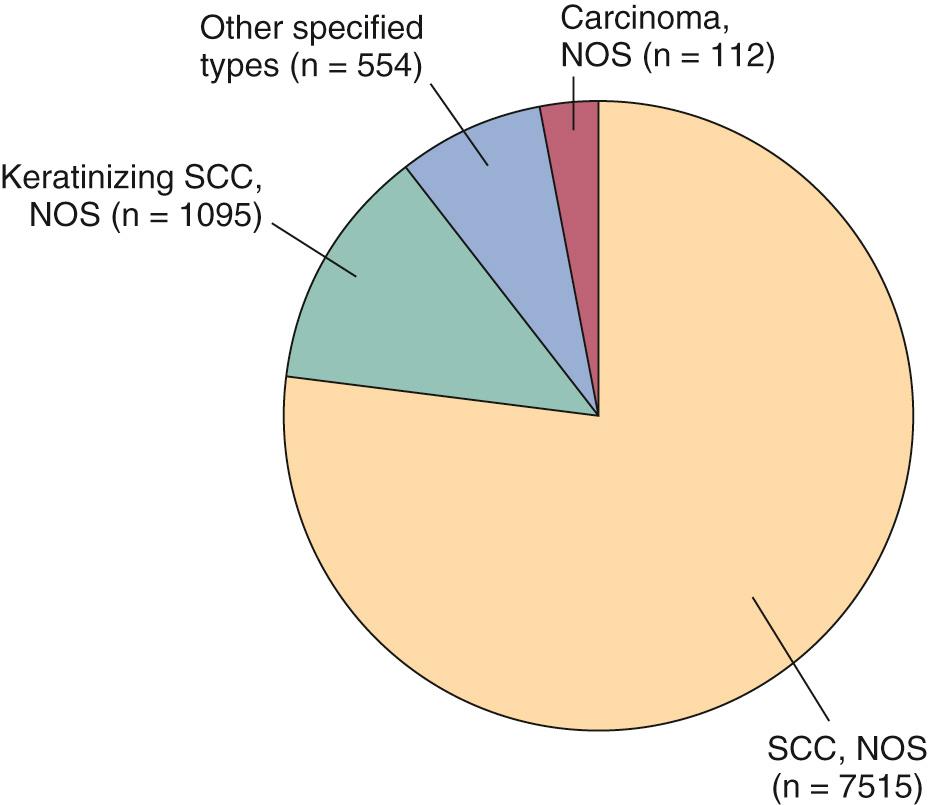
The most common site for laryngeal squamous cell carcinoma is the glottic larynx ( Fig. 106.6 ).
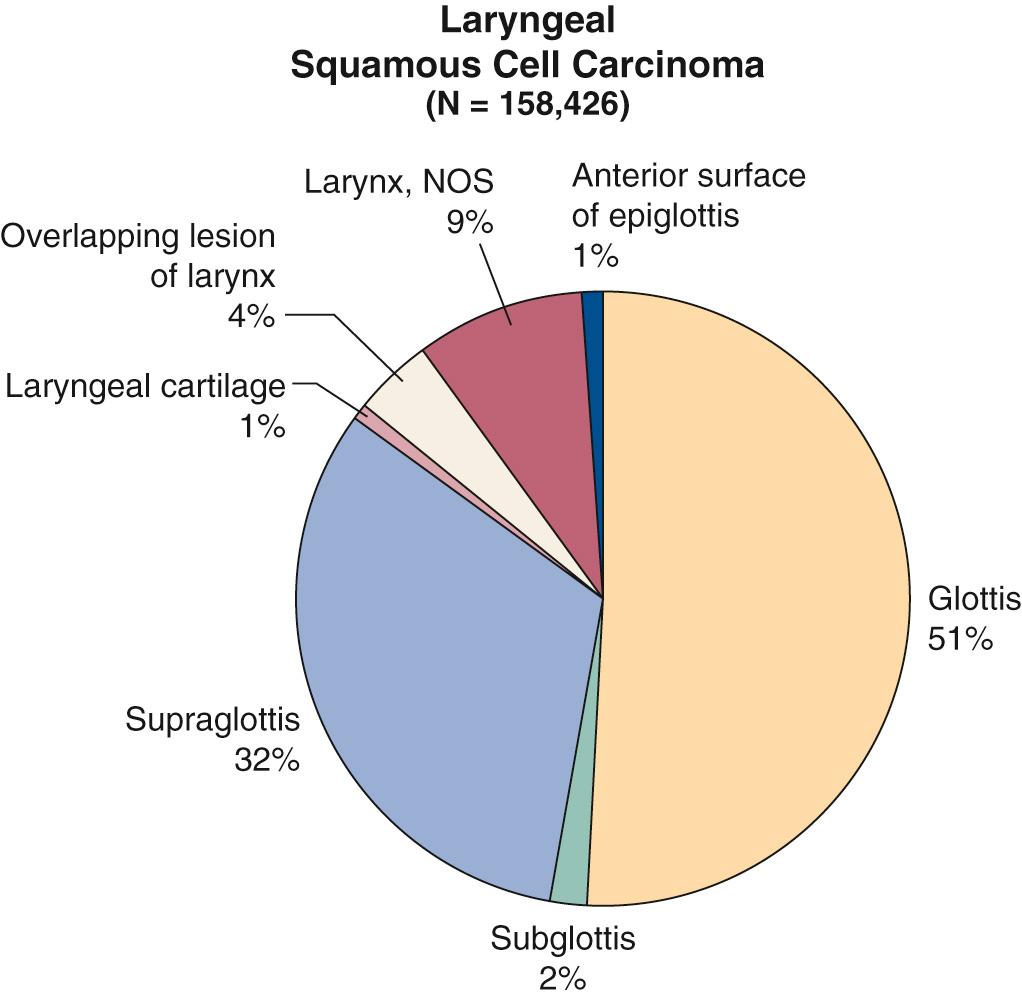
Become a Clinical Tree membership for Full access and enjoy Unlimited articles
If you are a member. Log in here